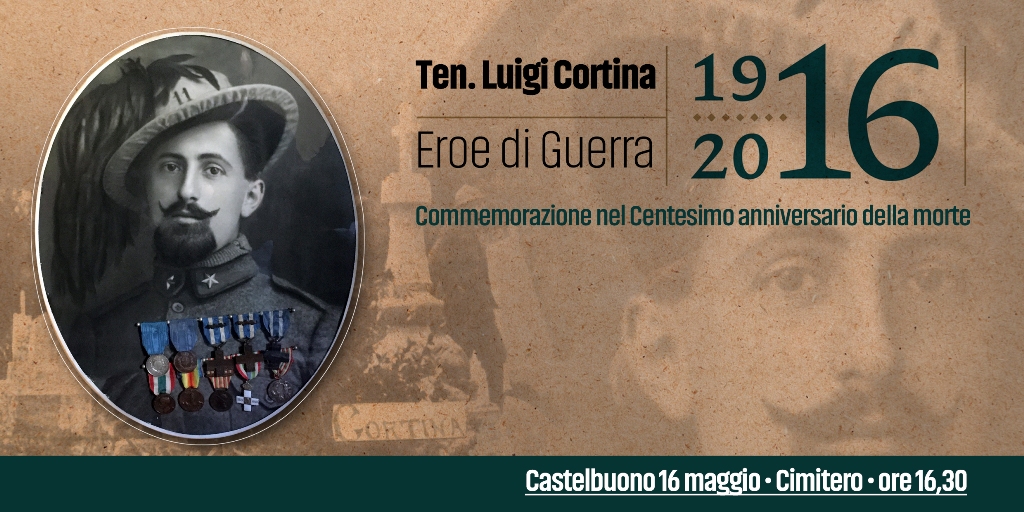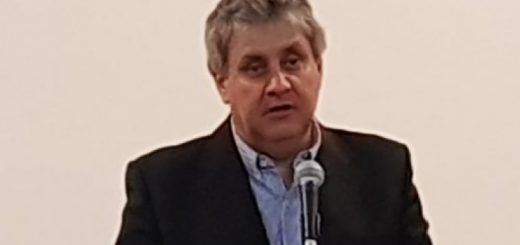Il 16 maggio 2016 la commemorazione nel centesimo anniversario della morte del Tenente Luigi Cortina

Il 17 maggio 2016 ricorre il centesimo anniversario della morte del tenente dei bersaglieri Luigi Cortina.
Era nato a Castelbuono l’8 marzo del 1893 e fin da giovane si era segnalato per la sua poliedricità e il suo fine eclettismo. Amava dipingere e l’arte del traforo, era appassionato di ciclismo e di lotta greco-romana. Eravamo entrati nel XX secolo da pochi anni, erano i tempi delle prime edizioni della Milano Sanremo, di Garrigou e di Petit Breton. Il lottatore triestino Giovanni Raicevich era considerato, allora, il più forte al mondo e di questo suo idolo aveva dipinto un enorme ritratto – quasi un murales – all’interno della sua casa di campagna, ai Pedagni. Nello stesso periodo (1911), a Castelbuono nasceva lo Sport Club Nebrodese e lui era fra i più appassionati animatori. Dopo essersi affermato in diverse gare locali di ciclismo, nel settembre 1912 si cimentò in una corsa sul percorso Termini-Cefalù e ritorno.
Per ricordarlo, in occasione dei cinquant’anni della morte, il suo amico Nzulo Cicero, su Le Madonie del 15 novembre 1967, fa la cronaca di questa corsa che fa capire quanto determinato fosse Luigi Cortina in tutte le cose con le quali intendesse misurarsi.
Alla partenza, quando fu dato il via, partì veloce, si portò in testa e tentò subito la fuga. Presto si trovò solo, anzi… troppo solo! Allora si accorse che aveva sbagliato percorso e dovette tornare indietro fino alla prima biforcazione. Frattanto il plotone dei concorrenti si era creato un vantaggio impossibile da colmare. Il percorso sulla litoranea non sarebbe stato difficile, ma era reso duro dalle condizioni delle strade, soltanto brecciate e cilindrate. Conveniva ritirarsi. Ma Luigi aveva una volontà di ferro e decise di portare a termine la corsa, a costo di arrivare ultimo. Già si avvicinava a Campofelice, rincuorato dal fatto di avere raggiunto e superati alcuni ritardatari, quando venne appiedato da una foratura. Nel giro di pochi minuti smonta la ruota ripara la camera d’aria rimonta la ruota pompa lo pneumatico e riparte con maggiore lena, per colmare lo svantaggio creatogli dalle avverse circostanze.
Quando taglia il traguardo volante di Cefalù, applaudito da un gruppo di amici accorsi dal paese per incoraggiarlo, si è già inserito nel gruppo di coda.
Il secondo tratto dalla corsa procede senza incidenti e Luigi, curvo sul manubrio, va superando, uno alla volta, molti concorrenti. Non è una corsa facile di fronte ai giovani tutti impegnati nello stesso fine. Ma la macchina umana di Luigi è potente ed è guidata da un cuore saldo e da una volontà eccezionale. Eccolo ora tagliare il traguardo finale, guadagnandosi il secondo posto e la medaglia d’argento e dimostrando che, in condizioni meno sfavorevoli, nessuno avrebbe potuto contrastargli il primo posto con grande distacco sul secondo. Lui era così, caparbio ai limiti della cocciutaggine.
Nel 1913 partì per la leva e venne assegnato all’11° battaglione ciclisti dei bersaglieri, dapprima a Napoli, quindi ad Ancona. Quando l’Italia entra in guerra, l’undicesimo battaglione ciclisti viene spedito nel Carso e Luigi è già un affermato sottufficiale.
Il suo comandante è Santi Ceccherini, un vecchio bersagliere e schermidore, medaglia d’argento di sciabola a squadre alle Olimpiadi di Londra del 1908. Più tardi sarebbe stato accanto a D’Annunzio durante l’impresa di Fiume e, nel 1922, mancare non poté alla marcia su Roma.
Partecipa alla seconda battaglia dell’Isonzo, combattuta dal 18 luglio al 3 agosto 1915, e tra il 20 e il 21 luglio è protagonista della battaglia del san Michele, dove funge da aiutante maggiore.
In quell’eroica azione, nella quale l’11° battaglione ciclisti, inizialmente un migliaio, lasciò oltre la metà dei suoi bersaglieri ed i quattro quinti dei suoi ufficiali, Luigi Cortina per portare ordini ai vari attraversò più volte quelle zone battutissime dalle mitragliatrici austriache poste a meno di duecento metri dalle postazioni italiane.
L’11° Battaglione ciclisti giunse per primo sul Monte san Michele, che occupò e tenacemente mantenne e fu proprio Luigi a conquistare la vetta (Chi piantò l’asta su la vetta ardente del san Michele e la lasciò nel pianto? O Castelbuono, un tuo figliuol fremente, Cortina, il bersaglier, tua gloria e vanto).
Espugnata la cima la sera, al mattino seguente gli uomini di Ceccherini e di Cortina furono contrattaccati da forze venti volte superiori. Scrisse il generale Cadorna: « …occupammo per una notte il S. Michele, ma è più facile prenderlo che restarci perché, appena conquistate le creste, ci coprirono di proiettili e poi un contrattacco ce lo portò via… ». Fu durante questa ritirata che Luigi Cortina salvò la vita al suo comandante il quale così scrisse: “A Luigi Cortina eroe purissimo del san Michele, monte fatale ma glorioso, io debbo la vita”. Per questa impresa, destinata a diventare leggendaria, al battaglione fu conferita la medaglia d’argento e a Luigi l’encomio solenne con la motivazione” Caduto fin dal primo sbalzo l’aiutante maggiore del battaglione, lo sostituiva nella trasmissione degli ordini adempiendo lodevolmente tale servizio in zone difficili ed intensamente battute”. La medaglia d’argento al valor militare gli sarebbe stata riconosciuta più tardi, a seguito di una istanza al ministero della guerra, del colonnello Ceccherini e dell’onorevole Aurelio Drago, deputato al parlamento del Regno per il distretto di Cefalù.
Luigi Cortina è protagonista anche durante la terza battaglia dell’Isonzo che si combatte dal 18 ottobre al 4 novembre 1915.
In particolare, alle trincee delle Frasche, nella zona di san Martino del Carso, il 2 novembre imperversava furiosa la battaglia. Il comandante di battaglione rimase ferito e Luigi “si occupava alacremente per la sostituzione del comando”, come si legge nell’encomio solenne che gli venne concesso, unitamente alla promozione sul campo a sottotenente per meriti di guerra. A causa dello scoppio di uno scrapnel, furono feriti gravemente diversi bersaglieri e, fra questi, il castelbuonese e suo caro amico Andrea Mazzola. Luigi Cortina, che era veramente un temerario, o forse anche un pazzo scatenato, si spinse fino alla distanza di 15 metri dalle trincee nemiche per recuperare il corpo dell’amico e, sotto una pioggia di proiettili, lo piglia fraternamente fra le braccia e per un camminamento impensabile lo conduce al posto di medicazione togliendolo da quel posto dove non più tardi di un quarto d’ora passava lo sterminio, la desolazione e la fine del mondo.
A fine aprile del 1916 venne ferito alla testa sul Monte Sei Busi ma non volle usufruire della convalescenza per cui ritornò al battaglione, ora guidato dal colonnello Augusto Sifola, che lo chiamò a ricoprire il ruolo di aiutante maggiore.
Il 15 maggio, per niente ristabilito dal ferimento e con le ferite ancora per niente rimarginate, benché scoraggiato dal colonnello Sifola a partecipare a Monfalcone alla pericolosa operazione a sostegno della cavalleria, non volle sentire ragioni, volle partire, e naturalmente si mise in testa al battaglione accanto al suo comandante, stoicamente. Dal ponte di san Valentino incominciarono le raffiche violente dell’artiglieria nemica e nel bosco, a nord della stazione ferroviaria, quelle micidiali delle mitragliatrici.
In quel boschetto, e vicino al suo colonnello Sifola, fu colpito mortalmente alla testa. Il colonnello sorresse l’eroe che il ferro nemico aveva spento in un attimo. Fu trasportato alle Scuole Popolari di Monfalcone, il più vicino posto di medicazione, dove i medici constatarono che nulla si poteva tentare. Due giorni dopo, “mentre il purpureo ventaglio del sole si chiude”, Luigi si assopisce nel sonno eterno.
Per questo sua ultima temeraria azione, gli fu conferita la medaglia d’argento al valor militare con la seguente motivazione: “Aiutante maggiore in secondo, in zona fortemente battuta dall’artiglieria e fucileria nemiche, con l’opera sua serena ed energica, coadiuvava il comando a riordinare le truppe ed a condurle là ove ferveva la mischia. Colpito da scheggia di granata, moriva stoicamente”.
Per tramandare ai posteri il nome del valoroso Luigi Cortina, i compagni d’armi gli eressero un monumento, a proprie cure e spese, nel Cimitero di guerra delle Scuole Popolari di Monfalcone, incidendo sul marmo questa epigrafe:
SOTTONENTE LUIGI CORTINA
CADUTO
EROICAMENTE A MONFALCONE
17 MAGGO 1916
L’11° BATTAGLIONE BERSAGLIERI CICLISTI
IN SAGRA MEMORIA POSE
Nel 1925 le sue spoglie mortali vennero traslate nel cimitero di Castelbuono dove, nel frattempo, con le pietra fatte arrivare dal Carso, era stata costruita la tomba monumentale del tutto simile, ma di maggior volume, rispetto a quella erettagli a Monfalcone dai suoi compagni del battaglione ciclisti.
Luigi Cortina è stato l’astro dei bersaglieri del san Michele, delle Frasche, di Monte Sei Busi, Vermegliano, Monfalcone e il suo eroismo, i numerosi suoi atti di valore egli ha lasciato quale scia luminosa ad esempio dei superstiti e dei nuovi figli della Patria. Le spalline d’oro per merito di guerra, e le sue eccelse decorazioni al Valore sono il crisma sacro di un astro magnifico che sorse – brillò – scomparve.
Noi, nipoti e pronipoti tutti, che dai suoi genitori, dalle sue sorelle e dai suoi fratelli ricevemmo e trasmettiamo ai nostri figli l’indefettibile affetto per questo non conosciuto zio, fulgido esempio di forza d’animo e di generosità, nobile e sfortunato figlio di questo nostro amato paese, lunedì 16 maggio 2016, con una cerimonia sobria e compassata, che si terrà al cimitero davanti al monumento che ne ospita le spoglie mortali, alla presenza delle autorità civili religiose e militari, cercheremo di onorarne degnamente la memoria.













